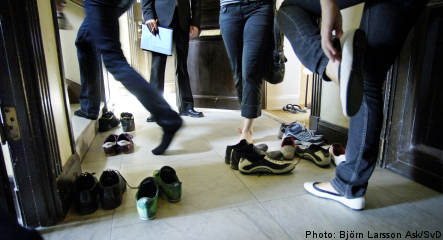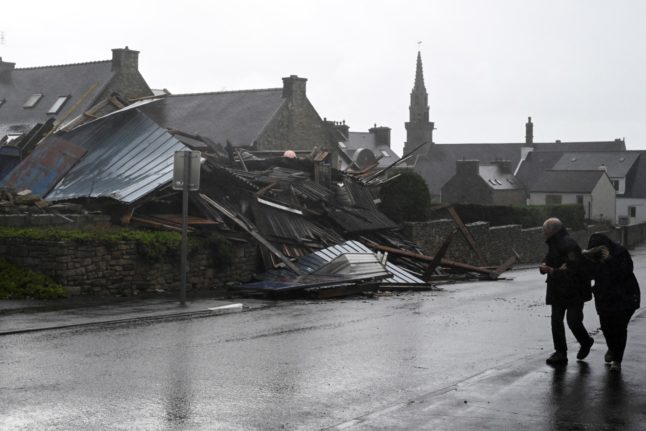When we moved here, Mr. Sweden, who always knows best, assured me that renting was better than buying. This was making a virtue of necessity: who could afford the exorbitant prices for a Stockholm flat anyway?
Besides, thanks to a severe housing shortage, scoring a rental within city limits made you automatically a Winner. A dysfunctional market, caused by Soviet-like restrictions on subletting, meant you needed connections, either to an apparatchik with the housing authorities or to a dealer in the black market–unless you parents had enrolled you on the housing waiting list before you were born.
Moreover, we lacked the pathological need to go into massive debt just to have our own roof to repair. Friends hinted that the reluctance to deal with sewage lines and termites was, if not quite a sin, certainly a sign of moral inferiority.
But with the bursting of the housing bubble came the nagging feeling that if one hoped to achieve the respectability of ownership, it was now or never.
Unwilling to abandon the bohemian insouciance of the renter but also wishing to become an upstanding member of the community–any community–we started searching for a city flat to buy in Sweden, France and Florida. I like to cast my nets wide.
When it comes to real estate, these are three different planets. In the US, the customer is king. The agent picks you up in a big German car and takes you to lunch. He spends weeks driving you around for viewings, chosen just for you.
In Stockholm the agent wants as little contact as possible with you. The typical apartment viewing lasts 45 minutes on Sunday when a horde of seekers wait on line, docilely remove their shoes and whip through the apartment in the crush of competitive buyers.
The Swedes are masters at what is known as Home Staging. Each flat has a red state-of-the-art espresso-maker in the kitchen and a white bowl of limes on the table. Was it the same espresso machine and limes, lugged from flat to flat by the agent? No trace of human habitation sullies the tasteful minimalism of the setting. The first question asked is, “har de gjort stambyte?”, which translates roughly as, “when was the last pipe system overhaul?”. This peculiar Swedish obsession with pipes was puzzling–until France.
In France, plumbing is not paramount. Queries about pipes elicited a baffled look and a diplomatic change of subject: had we noticed the majestic lines of the balustrade?
Although plumbing may not be a French priority, there is nevertheless plenty of kitchen sink realism. Literally. Dishes bearing remains from the last meal are often stacked up, waiting to be washed. This is, in its way, honest, showing what it looks like when real people live there. And they do. At one viewing the owner was stretched out on a sofa in her negligée watching TV, a dingy white poodle in her lap. Madame waved her cigarette in welcome and offered us a drink.
“The pipes appear to have burst” is the one indispensable French sentence. Finicky questions about those humid water stains on the ceiling were met with the trademark Gallic shrug and dismissed as “not a problem.” When the contents from your upstairs neighbour’s rotten pipes gush through your ceiling you simply go out and flag down one of the vehicles marked “SOS Plombier” which circulate the streets night and day.
But Mr. Sweden still had plumbing anxieties. Pressed to show us only places with renovated bathrooms, the agent found one that had been “conceived” by Philippe Starck, designer of the apartments of a French president. It boasted a sink made entirely of glass and a “rainforest shower.” We tested the shower. It rained. And it rained. We could not stop the rainforest rain. “Not a problem”: we trooped down to the street and waved over SOS Plumbers.
Unlike Sweden, in France sellers take the appliances with them when they move. An 86-year-old woman, however, was so eager to unload her Riviera apartment and return to Paris that she offered to throw her kitchen appliances into the deal. She proudly threw open her fridge door to prove it was in working order. Lined up like a small arsenal were 12 bottles of champagne and two of gin. The shelves in the door held a variety of pills that Apoteket would surely deny Swedish octogenarians. Nestled among the pills were jars of the most expensive Swiss and French beauty creams. There was no food.
Plumbing ceased to seem important. Surely a life popping corks on bottles of bubbly trumps sound pipes.
Speaking of popping bubbles, as housing woes deepen, approaches to selling are changing. In Stockholm there were only two people at a recent showing and the price had dropped by twenty percent.
Florida is holding a buy-one-get-one-free sale: two houses for the price of one. Hesitate and they’ll throw in a Lexus as an incentive. And in the most alarming sign of the meltdown yet, the French are considering Home-Staging.



 Please whitelist us to continue reading.
Please whitelist us to continue reading.